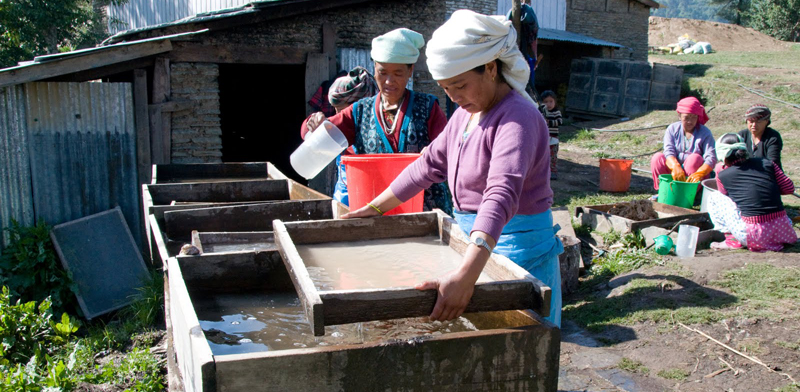Attractive, long-lasting and versatile, Nepal's Lokta paper is widely used and highly sought after both in the country and abroad. From official government documents to lamp shades, Lokta is a paper for all seasons.
Recently, while on a visit to a government office in Kathmandu, I'd happened to comment on the dreary stacks of paperwork that make up such an integral part of the operations in such places. I'd wondered how these files and documents survived all that rough handling and neglect. It was a friend who'd made me wise to the fact that government offices here use a specific type of paper, popular especially for its durability. I didn't know it at the time, but what she was referring to was 'Lokta' paper.
Now, Lokta paper is derived from the Lokta plant, also known vernacularly as baruwa and kaagte paat, a high altitude shrub. Two species of the Daphne plant – Daphne bholua and Daphne papyracea – are collectively referred to as 'Lokta', and it is the inner barks of these bushes that are used to produce the traditionally handcrafted paper. Lokta is generally found between the altitudes of 6500 and 9500 feet above sea level, growing widely across the Himalayan region. The western district of Baglung and Bhojpur in Nepal's east are where these plants particularly proliferate.
For those familiar with Lokta paper, it's not difficult to understand why it has been so widely used. For one, the rough texture gives the material a very distinctive appearance. It's also easily foldable and known to bypass the problem of corrugation. Additionally, Lokta's germ-free, insect resistant and waterproof quality makes it very tough, which is why it's been long utilized by the Nepal government for official purposes. The paper's benefits, though, do not end there. Lokta is also environmentally friendly –the harvesting of the plant itself has minimal ecological impact and the paper too is easily recyclable.
In October, which marks the commencement of the harvesting season, the stems of the Lokta plant are cut about 30cm above ground level without affecting the roots. In this way, the plant retains the ability to regenerate. It then takes about three to four years for the shrub to fully mature again.
Shiva Subedi, one of the leading handmade paper manufacturers in Nepal, says the process involves plenty of labour. "A large number of people are employed in the industry," he says. "We try to uplift the economic standards of the populace in rural communities by employing them."
"The use of Lokta benefits Nepal as it is entirely self-sustainable, so we don't have to depend on others. That is probably its biggest advantage," he adds.
Lokta's uses are varied and, perhaps, limitless. Manufacturers come up with new ideas every so often. Lokta Paper Craft alone has an assortment of products that range from the expected note books, photo albums, cards and bags to L.P. boxes, lamp shades, printing sets and wrapping paper to retain the effectiveness of incense. A number of stores in Thamel and Patan sell these products exclusively, and plenty is exported overseas, where the demand for the textured material is high.
It's safe to say that Lokta paper has carved a niche for itself in the local as well as international markets, made possible because of its distinctive appearance, versatility and durability. Not to mention the fact that it's come to be practically emblematic of official transactions here. As Subedi puts with pride – "Lokta is 100 percent uniquely Nepali."
source:www.ecs.com.np
